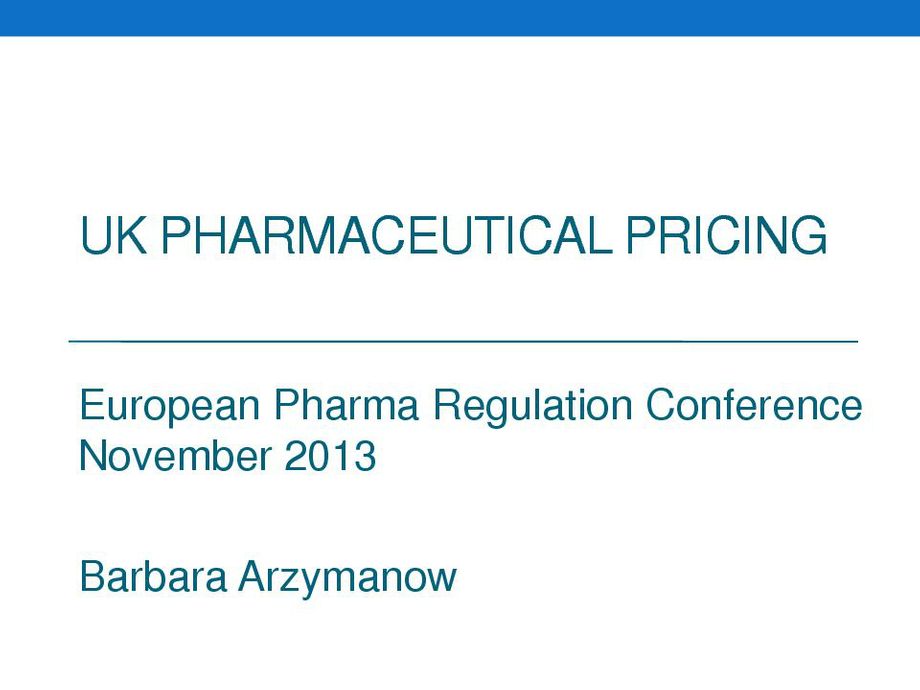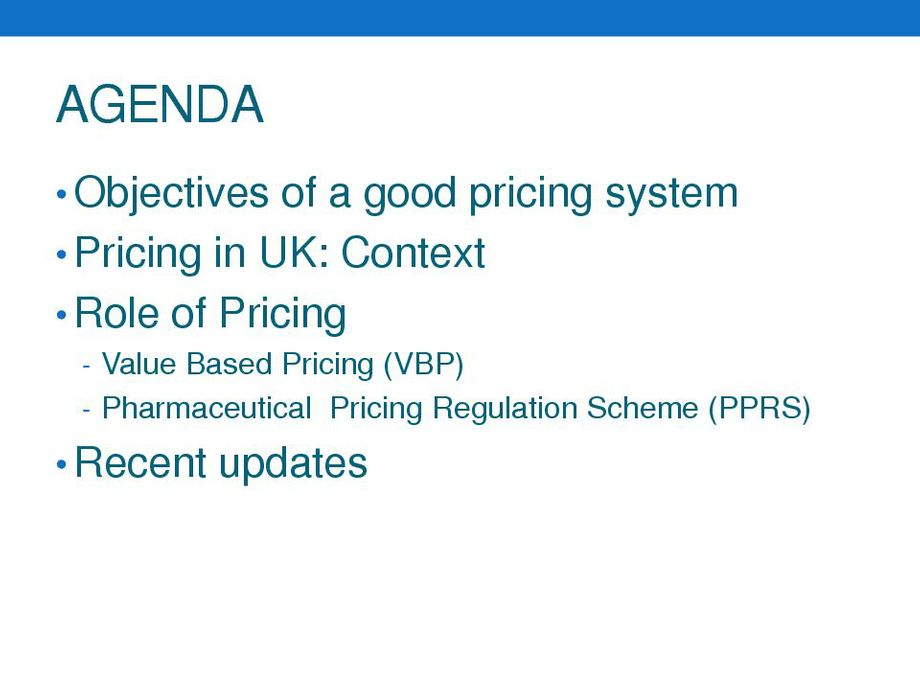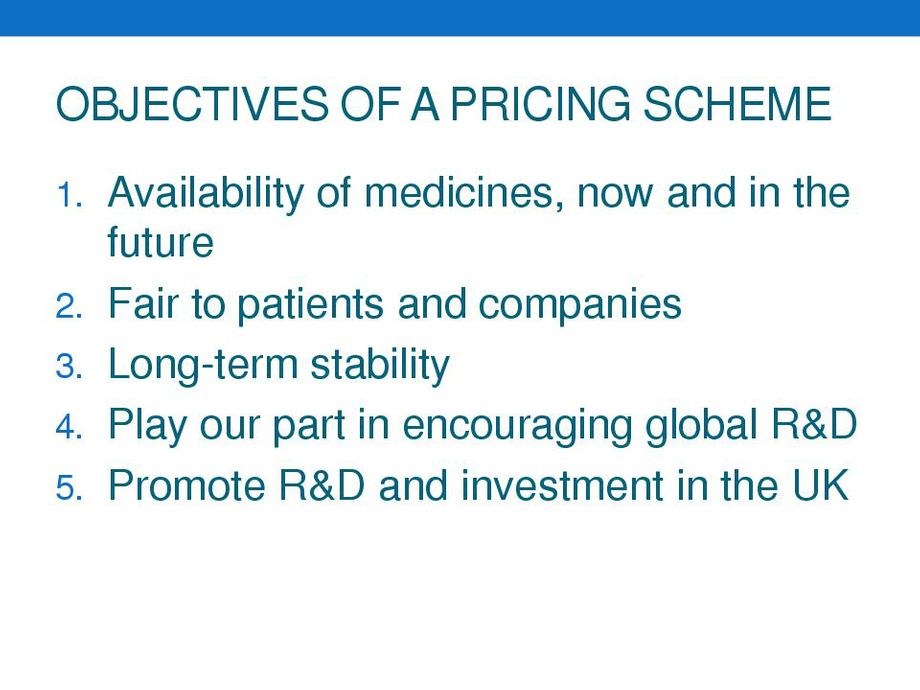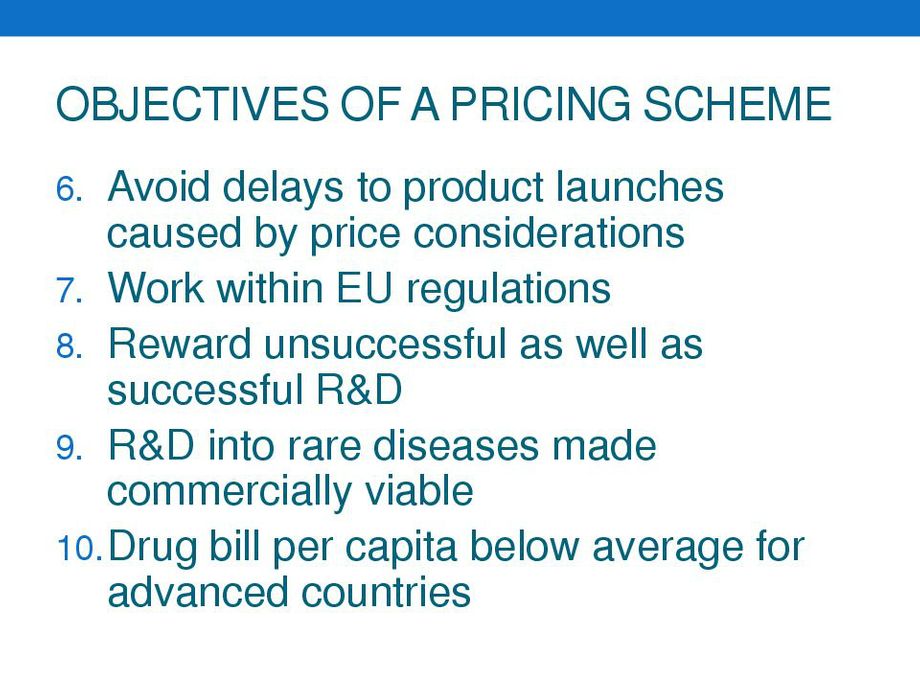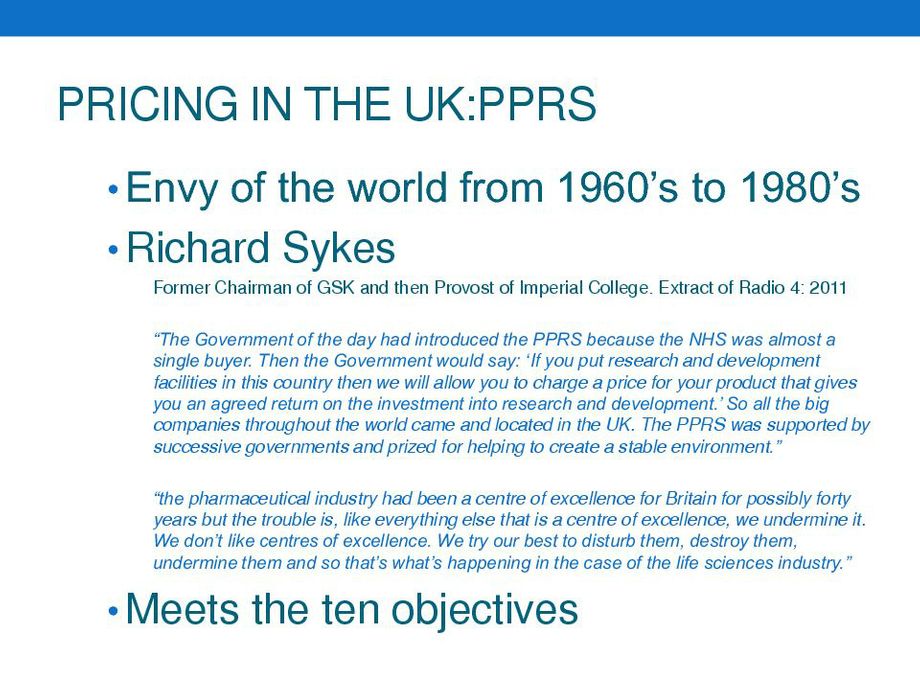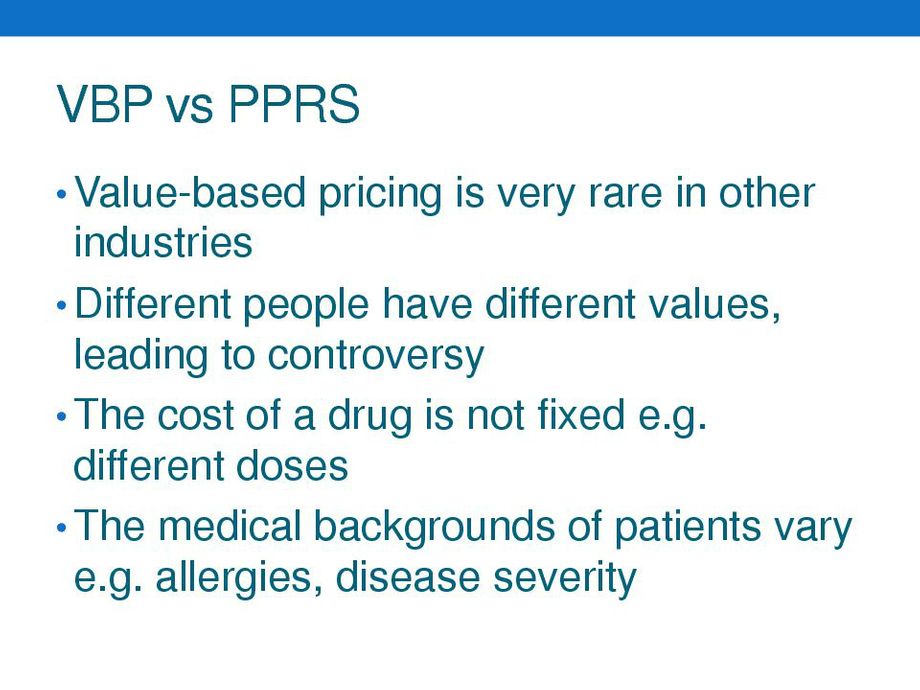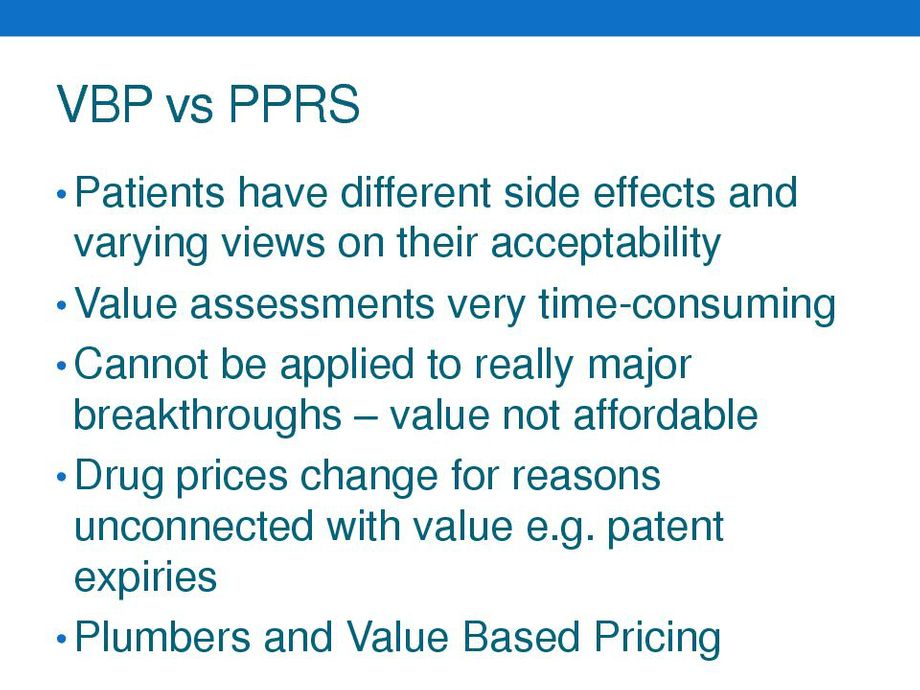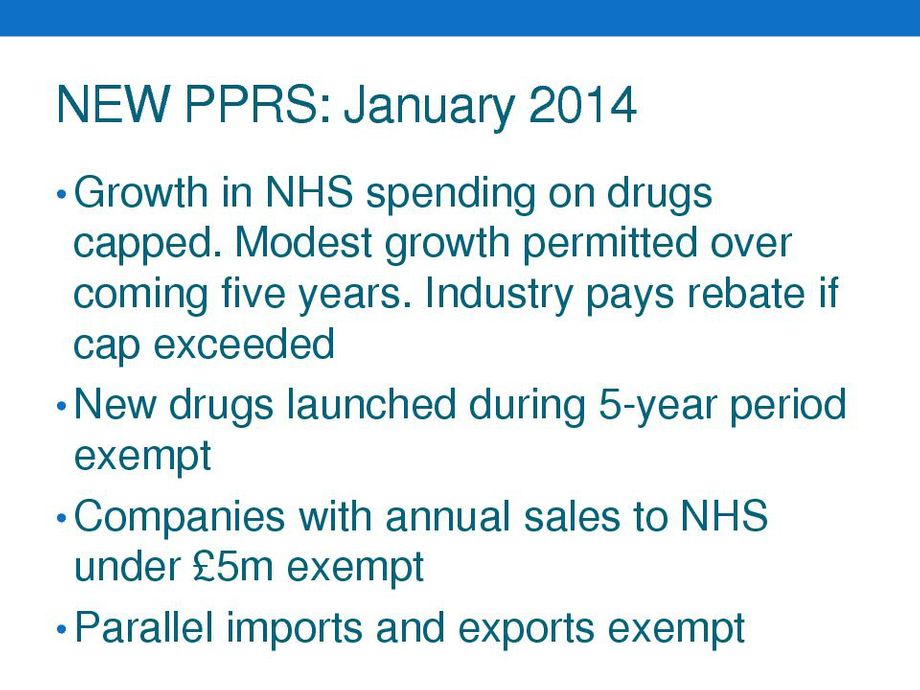THE SLIDES FROM BARBARA ARZYMANOW'S PRESENTATION ARE BELOW, FOLLOWED BY THE FULL TEXT OF HER SPEECH.
Many of you today have a varied familiarity with UK pharmaceutical pricing. Some of you have backgrounds in regulatory affairs unconnected with drug pricing. Others may specialise in the UK or European pricing systems. I will endeavour to pitch my comments at a level accessible to all and apologise if I am going over old ground.
I’d like first to comment on the objectives of a good pricing system.
Second, I will talk about the history of pricing in the UK.
Finally, I shall consider the role of VBP.
Last week was an important week with the final Heads of Agreement for the pricing in the UK being announced and I will run through the main points. All along I have supported the PPRS. Drug pricing policies are the most important indicator of how strongly each country really cares about this industry.
The most important aims of the Government with regard to pharmaceuticals are accepted by the drug industry.
Ten important objectives spring to mind:
1) As many valuable medicines as possible should be available to patients, now and in the future, as part of the provision of the best affordable healthcare.
2) We should be fair to patients and pharmaceutical companies.
3) There should be a stable long-term environment for drug companies.
4) We should encourage R&D and investment in order to promote the discovery, development and production of drugs that fulfil otherwise unmet medical needs. Few drugs have reached the market without a major input from one or more pharmaceutical companies. The emergence of important new medicines is one of the main drivers of improved health and longevity for mankind. Our responsibilities extend beyond the interests of the UK economy to playing our role as good international citizens.
5) We should be persuading pharmaceutical companies to invest in R&D and production in the UK so as to help the country’s economy and technology base.
6) We should avoid bureaucratic, inflexible systems that can delay the availability of valuable new medicines.
7) Work within EU regulations over parallel importing and exporting and lobby the EU for change when our national interests are compromised.
8) To reward companies for carrying out serious R&D whether or not it is successful, in order to encourage companies not to close or cut back on R&D following barren periods. R&D projects can often fail for reasons outside the control of the sponsoring company. It is important to encourage good science not just adding to the profits of companies producing block-busters which satisfy unmet clinical needs.
9) We should ensure that the system does not stifle R&D into rare diseases by causing only drugs that are used in large numbers of patients to be commercially viable. Some markets have become surprisingly establishedlike antiulcer drugs.
10) We should aim for a drug bill per capita below the average for advanced countries without compromising on the availability of drugs or the attractiveness of the UK business environment.
Having set out the key objectives of a good drug pricing scheme I now turn to the history of UK drug pricing.
Since 1957, the PPRS which is a voluntary system, has generally been renegotiated between the industry and the Department of Health every five years. From the 1960’s to the1980’s the PPRS was the envy of the world.
The UK combined low drug prices with an outstanding R&D track record based on past names like Glaxo, Beecham, Wellcome, ICI, Boots and Fisons. These were all independent British companies with a history of success. Many foreign companies, notably Pfizer and SmithKline, once had extremely successful R&D facilities here.
The slide shows a summary from Richard Sykes’ commentsafter Pfizer had announced its Sandwich closure plans. He strongly supported the PPRS.
A cheap drug may be fine for most patients but a person who cannot tolerate it, for example because of an allergy, may have no choice but to take a more expensive alternative.
Interestingly, countries that currently claim to operate value-based pricing systems can come up with quite different assessments of the value of products. These countries include Germany and Sweden but their drug pricing systems have been controversial. They are no longer seen as models for other countries.
VBP is a time-consuming process. The manpower does not exist to assess all products on the market even with the maximum amount of work being contracted out.
Andrew Lansley’s proposal was that value-based pricing should only apply to new products from January 2014 and that a revised PPRS should apply to the much greater number already on the market. This policy could, of course, result in similar products having quite different prices. VBP also fails to address a number of issues. For example, the price of a drug usually falls sharply after patent expiry whereas its value to patients is unaffected. Another important question is how to treat any dramatic discoveries such as a single cure for all cancers. The PPRS provides a framework that could handle such circumstances but a value-based price would simply be absurd.
VBP is like paying a plumber according to the damage that he prevents. If no other plumber was close enough to attend a leak quickly, the plumber would not be expected to price his work according to the value of the benefit.
The new final proposals to be implemented in January 2014 will be much more like a continuation of the PPRS rather than a revolutionary move to value-based pricing. Nevertheless, available financial resources need to fund the right products if patients are to receive the best treatment. NICE will continue to have an important role in giving advice on treatment. A gradual move towards assessing the value of individual drugs is healthy, especially when drugs have very high sales, but a system whose main focus is the value of individual drugs just will not work in practice. There is too much scope for controversy and opinion.
Jeremy Hunt is to be congratulated on the speed with which negotiations have got back on track following his appointment as Secretary of Health.
The new scheme places a direct cap on the industry’s total sales to the NHS. These will grow modestly over the coming five years. If the target is exceeded the industry will pay rebates. Exemptions will apply to drugs launched after January 2014, to companies with sales to the NHS below £5m per annum and to parallel imports and exports.
These measures support innovation and reduce bureaucracy. The final outcome is in keeping with my longstanding hopes and is a much better result for all concerned than if the value-based approach had gone unchecked.
